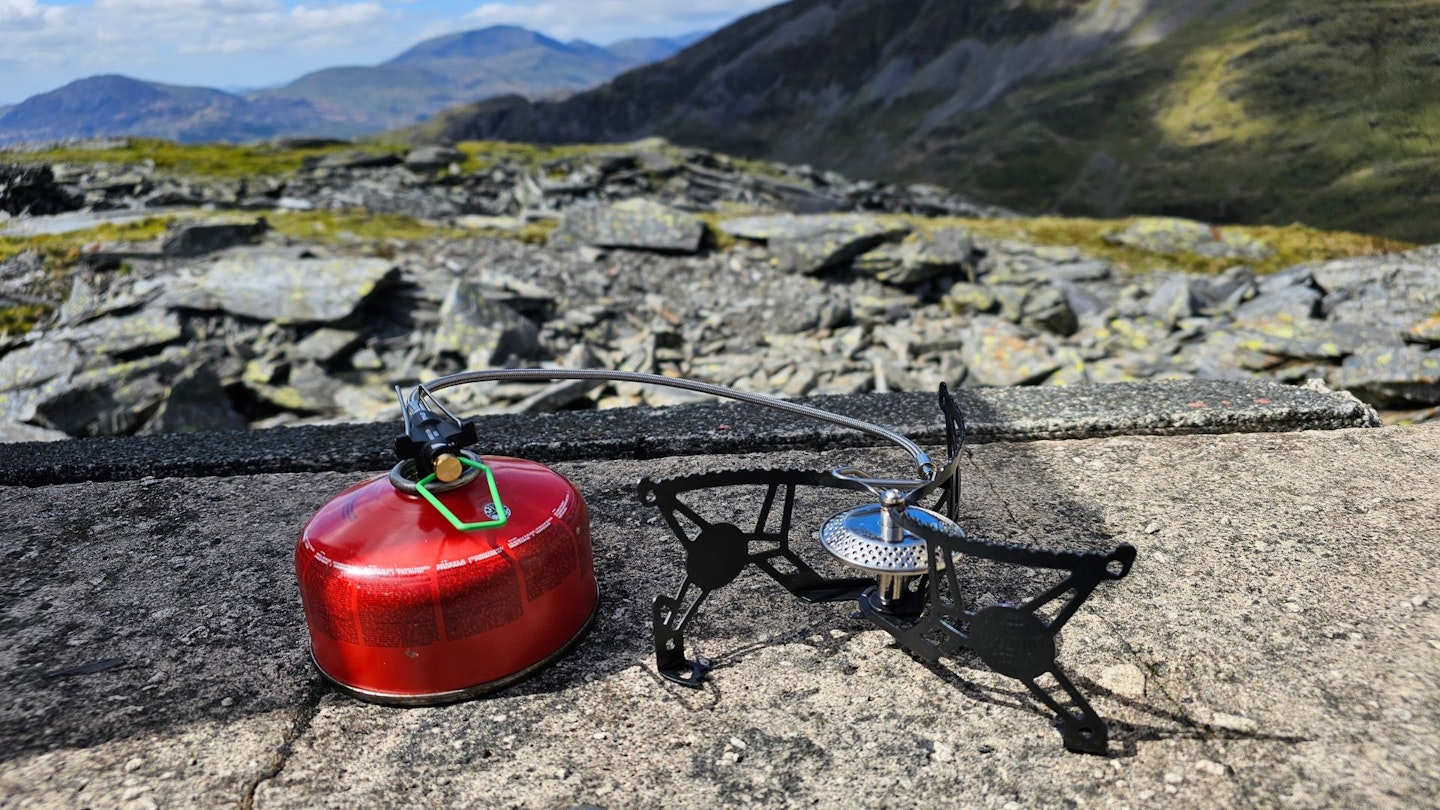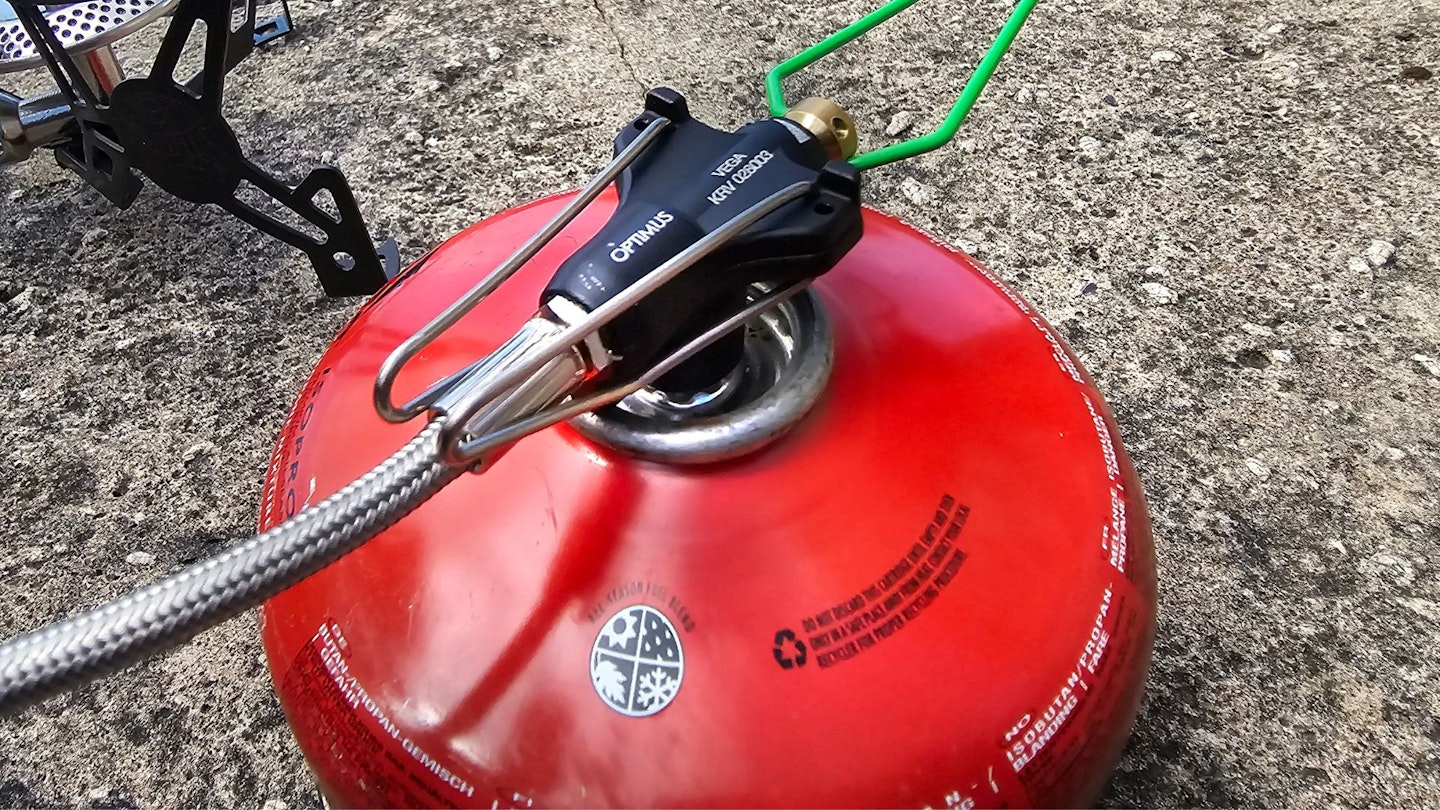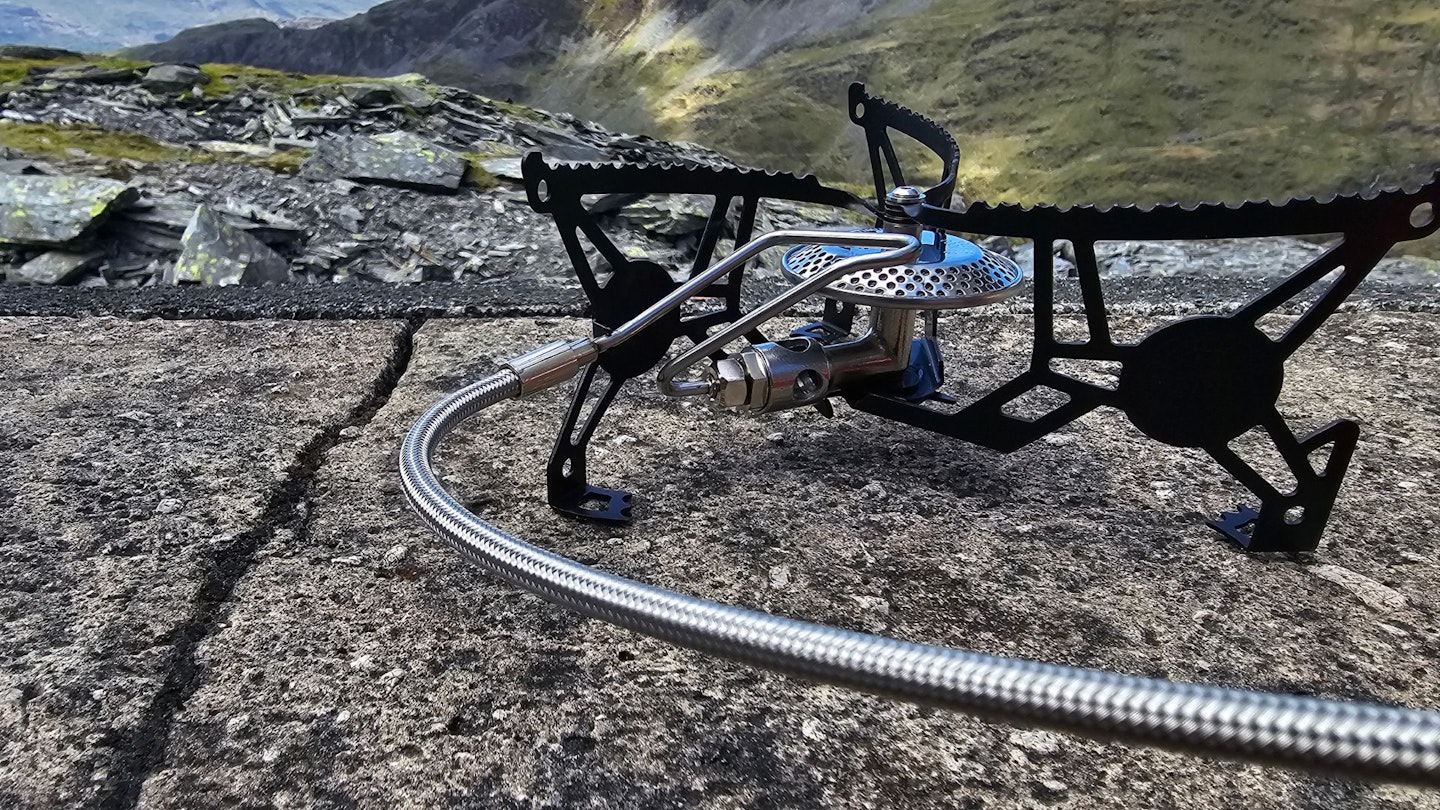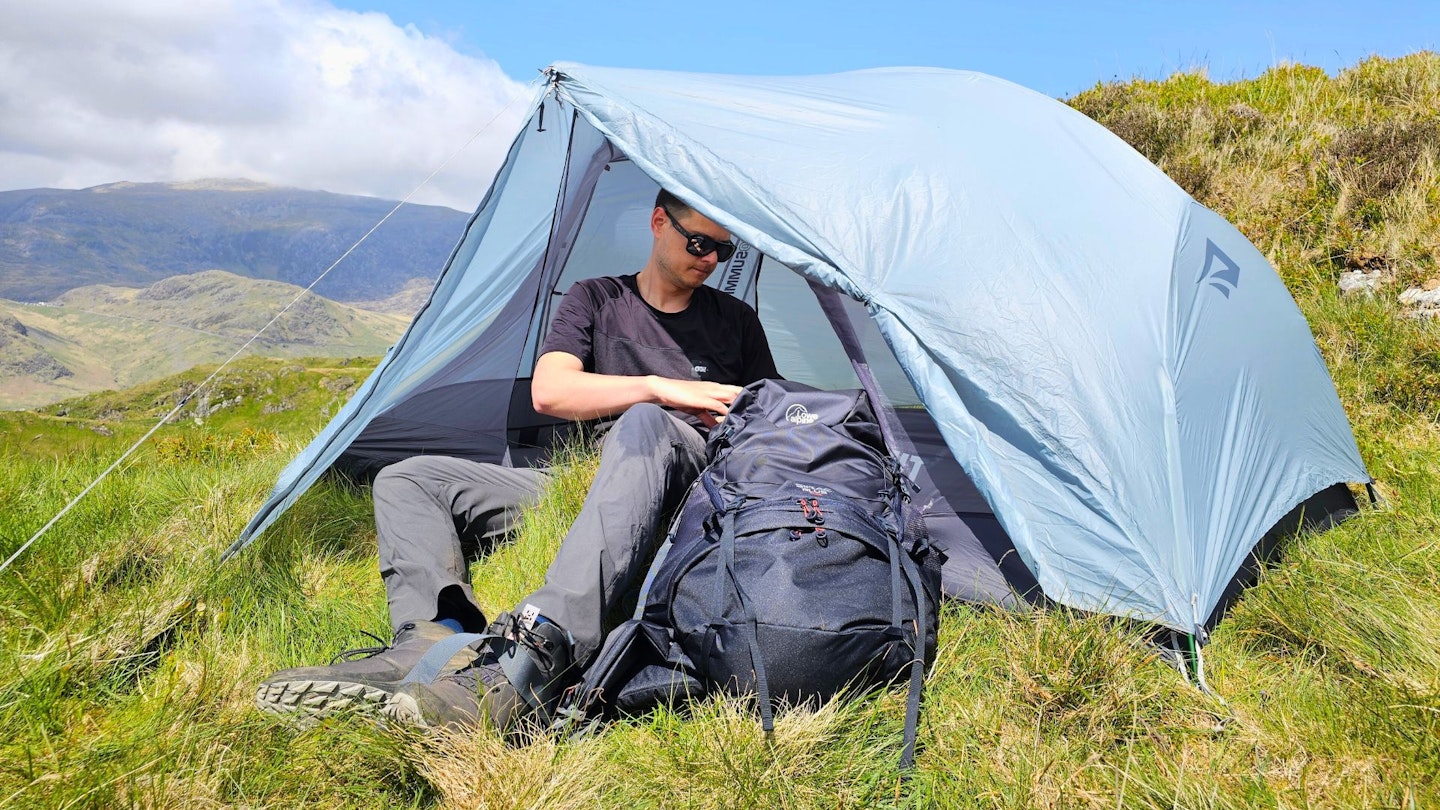Optimus has been manufacturing camping andbackpacking stoves for more than a century. Founded in Stockholm way back in 1899, the company has built an excellent reputation for its technically advanced, expedition-proven gas, multifuel and hybrid stoves.
Unlike screw-in stoves or all-in-one integrated cooking systems, the Vega is designed for cold and windy conditions. If temps plunge below zero, the hose-fed design means you can just invert your fuel canister and keep on cooking. This stove also has an extremely low centre of gravity for superior stability, ideal for cooking with larger pots and pans. And its precise flame control ensures you get a slow simmer rather than just incinerating your supper.
 LFTO
LFTOPros
- Wind resistance
- Simmer control
- Good fuel efficiency
- Good for winter camping
Cons
- Not the fastest boil times
- Expensive
- Heavier and bulkier than a screw-in stove
| Weight | 186g (216g packed in storage bag with ground shield) |
| Size | 14 x 10 x 6cm |
| Boil time | 4 minutes 36 seconds |
| Power output | 1,400W (4,777 BTU/hr) |
Design

The Optimus Vega is a little different to the other backpacking stoves in this round-up, since it is a remote canister or ‘spider’-style stove. This means the burner doesn’t screw directly onto the gas canister. Instead, it is connected by a hose. Although this makes it bulkier and heavier than a screw-in canister top stove, the design has several advantages.
Firstly, it keeps the gas canister and control bail well away from the hot burner head or the flame, maximising safety and minimising the chances of burned or scalded fingers and hands. Secondly, it reduces the overall height of your cooking set-up, making for better stability and improved wind resistance, since the stove sits much lower to the ground. In fact, with the Vega stove, your pot is only 7cm or so off the ground.

What’s more, the diameter of the triple fold-out pot supports is an impressive 17cm, which gives you a wide and very stable cooking surface for balancing bigger pots and frying pans. As such, this is a stove that works not only for solo backpacking use but also for small group camps. You can feasibly cook for 3 or 4 people on this stove if needed.
However, the major advantage of remote canister stoves over other types of gas stove is their superior performance in cold weather, especially in sub-zero temperatures. That’s because the design makes it possible to invert the gas canister (i.e. turn it upside down), which improves the flow of gas down the hose to the burner head, without needing the gas inside the canister to vaporise or boil off first.

This can prove vital when you’re camping well below freezing, when butane and even isobutane (two of the gases usually contained in camping gas mix) struggles to vaporise (boil). To further aid this process, the Vega is equipped with a brass pre-heater tube. This helps to vaporise the gas before it reaches the burner head. It also has double fold-out supports that help to stabilise the gas canister in inverted position.
The Optimus Vega comes bundled in a simple drawstring storage bag with a lightweight aluminium ground shield (a simple folded disc). This can be placed under the burner to prevent scorch marks and reflect radiated heat, further improving cooking performance.
Performance

The burner has a rated power output of 1.4kW in standard ‘efficiency’ mode (with the gas canister upright). So, it isn’t the most powerful stove around, though it performs well in terms of fuel efficiency, with much longer burn times than any screw-in stove. If you want to get the most out of your gas canister, this is a good choice.
In contrast, boil time in our controlled test was 4 minutes and 36 seconds for half a litre of water, slower than any other stove we tested. However, you can speed up boil times by about 20% if you switch to ‘4-season’ mode by turning the canister upside down, though this reduces fuel efficiency and simmering ability. Unless you’re particularly concerned about brewing up in super-quick time, it’s unlikely to be an issue.

And in real world conditions, the Vega outperforms most standard screw-in style stoves, thanks to its low centre of gravity that is naturally less susceptible to wind. On test in the mountains of Snowdonia, we found that a stiff breeze will cause the flame to move but still won’t blow the stove out. If you added a windshield, which is easy to do since the stove sits so low to the ground, you could make it pretty much windproof. Meanwhile, the 50mm wide burner head offers even heat distribution and minimises hotspots, so your food doesn’t just stick to the bottom of your pan. If you’re cooking rice, pasta or anything that usually requires plenty of stirring, this makes life a lot easier.
Of course, it’s when winter rolls around that this stove will really prove its worth. Our spring test period meant we didn’t get to try the Vega out in properly cold temperatures, but winter camping experience with other remote canister designs has taught us that they’re well worth their additional weight and bulk.
Weight and packed size

On our test scales, the Optimus Vega weighed in at 186g, or 216g when packed into its drawstring storage bag with the included ground shield. Remember that this stove lacks a piezo ignition, so you’d also need to add some sort of lighter to that packed weight.
In its bag, the packed dimensions measure approximately 14 x 10 x 6cm. This means it would nest easily enough in the bottom of a larger cooking pot, but even if you have to stash it in your pack, it doesn’t take up too much space. It was bulkier than any other stove on test with the exception of the chunky Campingaz Twister Plus Pz though.
Ease of use

This is a very practical stove. It is robust and well-built, with a squat design that ensures excellent stability. If you have ever accidentally upended a pot of boiling water in camp or (worse) knocked over a lit stove, you’ll know that it can cause a fair bit of drama – not to mention being dangerous. The design of the Vega virtually eliminates these risks. The teeth of the pot supports give a good grip on the base of your cooking pot, and the design of each arm actually increases in height from inner diameter to outer, preventing your pot from sliding around.
A large green wire control handle makes it easy to adjust the flame, whilst the remote canister design keeps fingers well out of harm’s way. Simmer control is also very good, enabling precise adjustment even at low power without the burner going out. It’s a slight shame that the stove lacks a piezo ignition, though it’s easy enough to light.
Price and competition

The Optimus Vega has a UK RRP of £139.99, which makes it a pricey stove. Shop around and you can usually find it for around £100 though. That’s still a sizeable outlay for a backpacking stove, but then, this isn’t the sort of stove that most beginner or novice wild campers would pick or need. It’s much better suited to experienced outdoorsy types who camp in all weathers and especially in all seasons. For winter camping, a remote canister stove is pretty much essential, and this is one of the best on the market.
Still, if you don’t need guaranteed sub-zero performance, we’d recommend saving some money and opting for either the SOTO Windmaster or the MSR Pocket Rocket Deluxe. Both offer good wind resistance and are considerably cheaper. Our only caveat to that recommendation would be if you’re particularly clumsy – in which case a ‘spider’-style stove like the Vega is going to be a lot safer and more stable. Similarly, if you know you’re going to be frequently cooking in confined spaces, like the porch or vestibule of a tent, then a spider stove tends to be a better choice.
If you do need a stove to do the job in such conditions, then other ‘spider’ stoves that are comparable to the Vega price-wise include the MSR Windpro II and the GSI Pinnacle 4-season. Both are worth a look, especially if you can find a good deal. Equally, there are rivals that are much cheaper, like the SOTO Fusion, the Robens Fire Bug and the Primus Express Spider II, though all are somewhat more basic than the Vega.
Verdict
A very stable and winter-ready ‘spider’ stove, ideal for all-season use. Not the cheapest or the lightest option for backpacking though, and arguably overkill for most trips.
How we tested the Optimus Vega Stove

Our tester for the this camping stove was Matt Jones. As the former editor of Walk magazine and Scouting magazine, Matt is one of the most respected names in the UK outdoor industry. He currently lives in Snowdonia with his partner Ellie.
